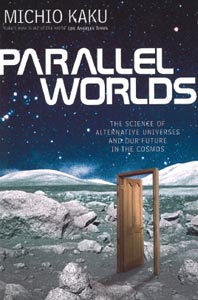by Michio Kaku, Allen Lane, Penguin Books. Hardback ISBN 0713997281, £20.00. (In the US, Doubleday. Hardback ISBN 0385509863, $27.95.)
While reading Michio Kaku’s latest book, Parallel Worlds, I left it for a few days on the coffee table at home. At this time we had a visitor who, although interested in science in general, is not a physicist. After browsing through the book, he started reading it and was disappointed to see it disappear one day when I went away on a trip. He has been inquiring about getting the book back ever since. Although based on limited statistics, this is an excellent recommendation for Parallel Worlds – you do not need to be a physicist to find the book fascinating.

But what does a (non-theoretical) particle physicist think about the book? Well, I really enjoyed it. It is a rather complete book on cosmology for the layman, taking us from Einstein to M-theory in a language that manages to be understandable without being trivial. If you, like me, would like to know the difference between 10- and 11-dimension string theory or find it difficult to explain to your fascinated friends (or to yourself) the concept of the holographic universe, this book will give you plenty of ammunition.
Kaku discusses all of the important theories, observations and experimental results that have shaped our understanding of the universe over the past century, and mainly the past 30 years. A big portion of the book discusses string theory, which is close to Kaku’s heart, in an informative and understandable way. The book is also full of Kaku’s accounts of his favourite science-fiction stories (when he wants to demonstrate a point that happens to have excited the imagination of science-fiction writers) as well as excerpts from the works of poets, other writers and Nobel laureates.
A large portion of the book, as its name suggests, revolves around the many different sorts of parallel universes that might exist and their relation (and possible interaction) with ours. The discussion eventually leads to ideas about how our distant descendants might try to escape a dying or inhospitable universe. Ironically, this was for me the least interesting part of the book, however it does devote a few pages to fascinating subjects such as the question of consciousness, the anthropic principle and religion.
Minor gripes include Kaku’s insistence on not using scientific notation: a trillion electron-volts means to me much less than 1 TeV, and how long exactly is 30 billionths of an inch? Surely Kaku’s intended audience would be less perplexed by 1018 than by “a million trillion”. Another point is his assertion that particle physicists have introduced “hundreds of point-like particles” to the theory. Three families of four fermions each do not make hundreds of particles.
The book also includes a useful index and a glossary, and has notes with further explanations, which unfortunately I found only after I had finished reading the book. It would have been helpful to include note numbers in the text.
Should you go out and buy this book for Christmas? The answer is yes. Parallel Worlds is an excellent read. Just do not leave it on the coffee table.








